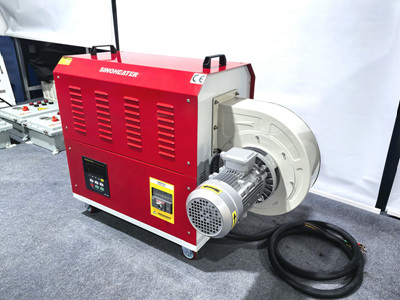Critical Considerations for Selecting Corrosion-Resistant Heat Blowers in Chemical-Exposed Environments
Heat blowers operating in chemical-laden settings face accelerated degradation from corrosive gases, vapors, or liquids, leading to premature failure, safety hazards, and costly downtime. Selecting materials and designs that resist chemical attack requires evaluating environmental exposure, maintenance protocols, and industry-specific standards. Below are actionable insights to ensure long-term durability and performance in aggressive chemical environments.
Assessing Chemical Compatibility with Housing and Component Materials
Stainless Steel Alloys for Broad Chemical Resistance
Austenitic stainless steel (e.g., 304 or 316 grades) is widely used in chemical processing due to its resistance to oxidation, chlorides, and organic acids. However, not all stainless steels perform equally—316L offers superior corrosion resistance in environments with sulfuric acid or saline solutions compared to 304. Verify the steel’s grade through material certifications and avoid recycled or low-grade alloys, which may contain impurities that reduce durability.
Non-Metallic Enclosures for Highly Aggressive Chemicals
In settings with strong acids (e.g., hydrochloric or nitric acid) or solvents, fiberglass-reinforced plastic (FRP) or polyvinyl chloride (PVC) enclosures outperform metals by resisting chemical penetration and stress cracking. FRP is particularly effective in outdoor applications, as it withstands UV exposure and temperature fluctuations without degrading. Ensure non-metallic materials are rated for continuous use at the heat blower’s operating temperature to prevent softening or deformation.
Coated Metals for Cost-Effective Protection Against Mild Corrosion
For environments with low to moderate chemical exposure (e.g., cleaning agents or diluted acids), epoxy or polyester powder coatings provide a barrier against oxidation and chemical reactions. These coatings are applied electrostatically and cured at high temperatures, creating a hard, non-porous surface. Check for coatings that meet ASTM B117 salt spray standards or ISO 9227 cyclic corrosion tests, which simulate long-term exposure to harsh conditions.
Design Features to Minimize Chemical Retention and Contamination
Seamless Construction and Rounded Edges to Prevent Trap Points
Welded seams or sharp corners in heat blower housings can trap chemical residues, leading to localized corrosion and bacterial growth in food or pharmaceutical applications. Opt for units with seamless, one-piece molded enclosures or laser-welded joints that eliminate gaps. Rounded edges and smooth interior surfaces further reduce residue accumulation, simplifying cleaning and extending service life.
Drainage Ports and Sloped Designs for Liquid Runoff
In environments where condensate or chemical splashes occur, heat blowers with integrated drainage ports or sloped bases prevent liquid pooling, which accelerates corrosion. Some models include automatic drain valves triggered by temperature or pressure changes, ensuring timely removal of corrosive liquids. Ensure drainage systems are compatible with the facility’s waste disposal protocols to avoid environmental contamination.
Removable Panels and Tool-Free Access for Regular Maintenance
Corrosion-resistant heat blowers still require periodic inspection and cleaning, especially in high-exposure settings. Choose units with quick-release latches or hinged panels that allow technicians to access internal components without specialized tools. This design reduces maintenance time and ensures thorough cleaning, as operators can reach hidden areas where chemicals might accumulate.
Environmental Controls to Reduce Chemical Exposure and Corrosion Rates
Ventilation Systems to Dilute Corrosive Vapors
In enclosed spaces, poor ventilation causes chemical vapors to concentrate, increasing the risk of corrosion and health hazards. Pair heat blowers with local exhaust ventilation (LEV) systems that capture and remove contaminants at the source. For example, downdraft tables or canopy hoods positioned near chemical storage areas can reduce vapor density by up to 90%, slowing the degradation of nearby equipment.
Temperature and Humidity Regulation to Slow Chemical Reactions
High humidity accelerates corrosion by facilitating electrochemical reactions between metals and chemicals. Use heat blowers with built-in dehumidification or integrate them with HVAC systems to maintain relative humidity below 60% in chemical storage or processing zones. Additionally, avoid overheating, as elevated temperatures can increase the reactivity of certain chemicals (e.g., peroxides or amines), leading to rapid material breakdown.
Chemical Filtration for Air Intake Protection
Heat blowers drawing air from contaminated environments risk ingesting corrosive particles or vapors, which can damage internal components like motors or heat exchangers. Install pre-filters with activated carbon or HEPA layers to trap volatile organic compounds (VOCs) and particulates before they enter the unit. For highly toxic settings, consider scrubbers or catalytic converters to neutralize harmful gases, extending the heat blower’s lifespan.
Testing and Certification Standards for Corrosion Resistance
ISO 9227 and ASTM B117 for Accelerated Corrosion Testing
Manufacturers often subject heat blowers to standardized corrosion tests to simulate long-term exposure. ISO 9227 (cyclic corrosion testing) combines salt spray, humidity, and drying cycles to replicate real-world conditions, while ASTM B117 (salt spray testing) assesses resistance to chloride-induced corrosion. Look for units that meet or exceed these standards, with test durations of at least 500 hours for reliable performance in marine or industrial environments.
NACE MR0175/ISO 15156 for Oil and Gas Applications
In oil refineries or offshore platforms, heat blowers must resist sulfide stress cracking (SSC) caused by hydrogen sulfide (H2S) exposure. NACE MR0175/ISO 15156 certifications ensure materials like duplex stainless steel or nickel alloys can withstand H2S concentrations up to 10,000 ppm without cracking. Verify that the certification covers the specific pressure and temperature conditions of your application to avoid failures.
UL 1995 and CSA C22.2 No. 236 for Electrical Safety in Corrosive Zones
Electrical components in heat blowers are vulnerable to corrosion-induced short circuits or insulation breakdown. UL 1995 (for heating and cooling equipment) and CSA C22.2 No. 236 (for room heaters) include tests for enclosure integrity, wire insulation resistance, and grounding reliability in corrosive atmospheres. Units meeting these standards are less likely to pose fire or shock risks, even after years of chemical exposure.
By prioritizing material compatibility, design features, environmental controls, and certifications, buyers can select heat blowers that maintain performance and safety in chemical-exposed environments. Seamless construction, drainage systems, and ventilation reduce corrosion risks, while standardized testing ensures compliance with industry benchmarks for durability and reliability.




